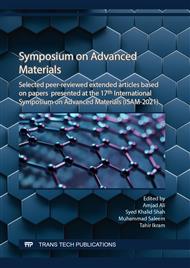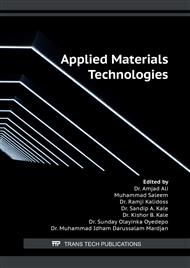p.103
p.113
p.119
p.127
p.139
p.145
p.153
p.163
p.177
Preparation Structural and Optical Analysis of Tungsten Sulphide (WS2) Thin Film by DC-Sputtering
Abstract:
Tungsten Sulfide (WS2) has been appeared as visible range semi-conductors with having substantial direct band gap. In two-dimensional (2D) transition metal dichalcogenides (TMDC) i.e.WS2 has been growing research attention over more than the past twenty years in low cost, energy-efficient, adaptable or environment-friendly material, which is crucial part of optoelectronic emission devices. WS2 semiconductor thin films were grown on glass and Si substrates by using DC sputtering method. During deposition the substrate were kept at temperature of 200°C. The thin films were studied by X-ray diffraction, UV-Vis spectrometry and Spectrofluorometer (FS5). XRD analysis revealed the nature of grown film effected by temperature of substrate results in to be amorphous. Photoluminescence analysis at 532nm and optical study proved the direct to indirect band transition in WS2.
Info:
Periodical:
Pages:
139-144
Citation:
Online since:
August 2022
Authors:
Keywords:
Price:
Сopyright:
© 2022 Trans Tech Publications Ltd. All Rights Reserved
Share:
Citation:



